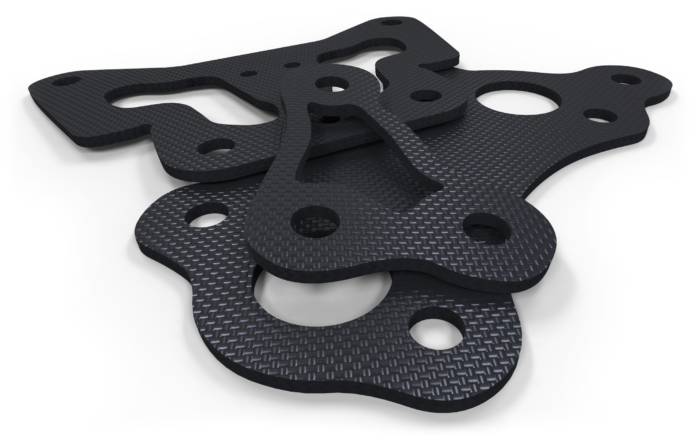Machining Carbon Fiber, All You Need to Know
Carbon fiber machining has opened up several new opportunities in the manufacturing industry due to its unique strength-to-weight ratio and durability. Carbon fibers surpass other traditional materials like aluminum, steel, wood or glass in terms of CNC machining applications. It is also a lightweight material which creates high-performance components.

Carbon fiber sheets are usually machined using routers but other standard methods can be used as well. This article dives into the properties of carbon fiber, the process of machining carbon fiber sheets and its applications while providing some tips to get better results from machining carbon fiber.
Table of Contents
- Carbon Fiber and Its Properties
- Application of Carbon Fiber Machined Parts
- Carbon Fiber Sheets Machining
- The Tips for Carbon Fiber Machining
- Conclusion
- Carbon Fiber and Its Properties
Carbon fiber machining involves the cutting, shaping, and finishing of parts made with carbon fiber composite materials. Carbon fibers are extremely light, strong, rigid and resistant to abrasion and corrosion. They are used in a variety of applications, including sports equipment, aerospace components, and engineering tools. Carbon fiber machining is essential for creating the parts needed for these industries due to its superior strength and light weight.
Carbon fiber is an excellent material to use for machining due to its low thermal expansion, EM transparency, attractive aesthetics, electrical conductivity, and other advantageous properties. With the right processing method, carbon fiber can be used to produce parts that are lightweight yet strong and durable.
- Application of Carbon Fiber Machined Parts
Carbon fiber machining technologies have made it possible to fabricate specialized
parts from this high-performance material. Carbon fiber is used in a variety of industries, from aircraft manufacturing to auto racing, thanks to its exceptional mechanical properties, thermal conductivity, and low coefficient of thermal expansion. The use of carbon fiber for machining has allowed engineers to create high-performance components for a number of applications.
- Aerospace Industry
Carbon fiber machining technologies enable the aerospace industry to use the material for specific components instead of titanium and aluminum. The strength-to-weight ratio of carbon fiber makes it an ideal choice for this sector, as well as a variety of other industries that need lightweight but high-performance parts.
It is used in the construction of aircraft components such as gliders, jets, and helicopters due to its strength and weight-saving properties. Using carbon fiber helps reduce fuel consumption significantly by decreasing the overall weight of the aircraft.
- Sports Industry
Due to its advantages, it is frequently used for professional athlete’s tennis rackets, bicycle wheels, helmets, bicycle frames, archery bows, hockey sticks, golf clubs and more. However, carbon fiber does not only provide strength but it also produces clothing and protective gear such as leg-guards and arm-protectors for particular sports.
Moreover, athletes who partake in extreme or racing sports are provided with superior lightweight helmets and shoes which improve the athleticism of those wearing them. Carbon fiber has thus become an ideal material for making sporting equipment because it enables athletes to move faster while bearing less weight.
- Electronic Industry
Carbon fiber offers a variety of advantages for use in the electronics sector. It is lightweight, which is an attractive quality for most customers, and gives higher natural frequency and greater dimensional precision than metal or plastic enclosures. Carbon fiber shares a thermal coefficient (CTE) similar to that of invar, helping reduce thermal issues for sensitive equipment like sensors, mirrors and lasers. The material is also electrically conductive and nonmagnetic, making it useful for applications ranging from manufacturing electronic shielding devices with good electromagnetic wave absorption abilities to creating composite materials with enhanced mechanical properties.
- Automotive Industry
Carbon fiber is a strong and durable material long used in the automotive sector for constructing car frames and components. One of its primary advantages is its superior strength-to-weight ratio, which has enabled manufacturers to create lighter and faster cars on the market. In addition, carbon fiber can replace metal parts in vehicles to reduce costs while simultaneously improving fuel efficiency and lowering emissions of CO2.
- Carbon Fiber Sheets Machining
Bellows are some of the most common ways of machining carbon fiber:
CNC Turning Machining
CNC turning is an essential manufacturing technique used to produce precise and accurate parts from carbon fiber materials. Specialized tools are used during the process, such as ceramic, cemented carbide, polycrystalline diamond and cubic boron nitride. Different parameters such as cutting speed, feed rate, depth of cut and tool geometry must be taken into account to determine the surface roughness of the carbon fiber parts. The quality of the machined components is determined by these parameters, which ultimately influence tool life and machining performance.
CNC Milling Machining
CNC milling is an efficient method for machining carbon fiber composite parts. This process requires the spindle speed to be higher than when milling metals, while the feed rate must be lower. Additionally, the tool and tool path need to be adjusted in order to manage the heat generated during machining as it may damage the resin and cause abrasion on the cutting tool. Special tooling is also required to help prevent fracturing of the fibers. By properly adjusting these parameters, CNC milling can produce quality parts with carbon fiber composites.
Drilling Machining
Drilling is an intricate process that is used in machining carbon fiber composites. Carbon fibers can chip or wear away upon precision machining, and its conductive dust often damages electronics and irritates the skin. Therefore, it is important to take preventive measures such as wearing a dust mask and gloves during the process. The drilling speed needs to be adjusted according to the size and depth of the hole, and special drill bits designed for carbon fiber help prevent delamination.
Waterjet Cutting
Waterjet cutting is a fast and precise technique for cutting carbon fiber composites. It requires no special tool or preparation work, making it an efficient and convenient process. Besides being fast and easy to use, the waterjet machining process also offers dust containment benefits due to the presence of water. However, delamination may occur if a starting drill hole is not present. For tight tolerances, it’s advisable to cut out large parts with waterjet technology before finishing off any adjustments manually.
- The Tips for Carbon Fiber Machining
There are some helpful tips that can improve the results of carbon fiber machining, they are:
Improving the wear resistance of the drill bit
A drill bit is a cutting tool designed to create holes in material, such as wood, metal or other materials. When drilling into carbon fiber composites, the cutting temperature is usually lower compared to other materials, but the high hardness of carbon fiber can cause abrasive wear on an HSS drill bit due to the hard fiber points. To minimize this wear, it is recommended to use high-hardness tool materials such as hard alloys, ceramics, cubic boron nitride and diamond when processing carbon fiber composite materials with a drill bit.
Pollution Control
Pollution control can be improved through different drilling methods. The addition of water-based cutting fluid to the drilling process prevents dust particles from being dispersed into the air, which helps reduce pollution. Test results indicate that adding this cutting fluid does not have a negative effect on tool durability or hole quality. A more effective way to protect against dust pollution is to use robot drilling, as this method safeguards workers by ensuring accurate hole-making, and keeping them away from contaminated environments.
Reasonable Technology
Tooling technology is an efficient and effective method for improving the surface roughness and roundness of holes in materials such as carbon fiber composites. To do this, a reaming knife made of wear-resistant hard alloy is used at a cutting speed of around 30m/min to machine the hole. The finish obtained on the rear wall after reaming is Ra3.2 or better. Furthermore, composite tooling can be employed to ensure accurate machining when working with carbon fiber composites.
- Conclusion
Carbon fiber has a distinct look and an array of advantageous features, allowing parts to be lighter in weight while maintaining their structural integrity. Utilizing a CNC router is a great way to precisely cut carbon fiber sheets with greater speed than manual tools. Nevertheless, opting for machining with a CNC machine is highly recommended as it will decrease the chances of any unsatisfactory outcomes or wasted material.
